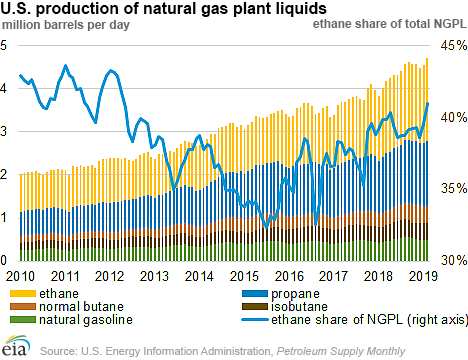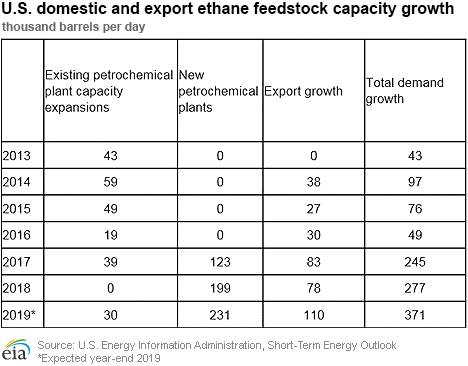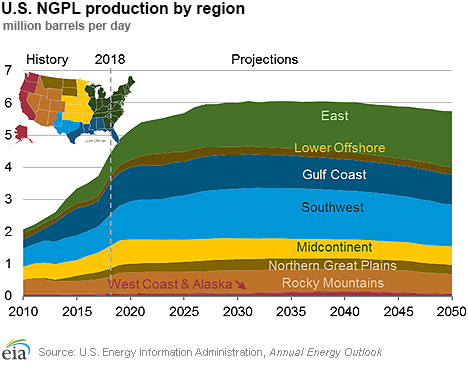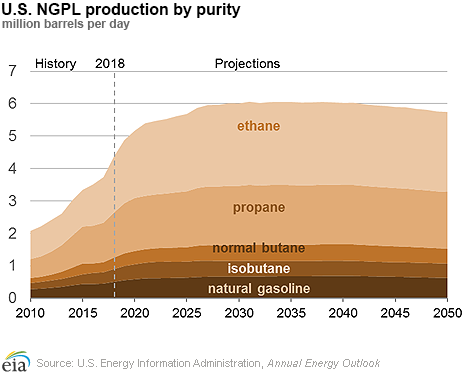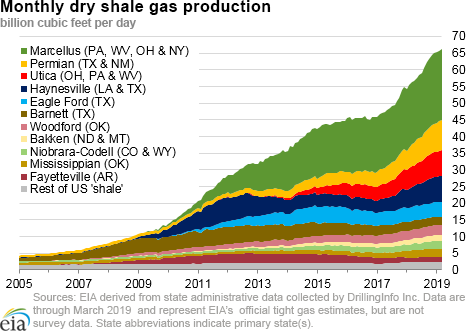In the News:
U.S. natural gas plant liquids production hits new record in February
Strong natural gas production, as well as rapidly-rising demand, resulted in record-high production of natural gas plant liquids (NGPL), which reached 4.7 million barrels per day (b/d) in February 2019. Growth in NGPL production, a subset of hydrocarbon gas liquids (HGL), was led by ethane, which also set a new record, which was nearly 130,000 barrels per day (b/d) higher than in the previous month.
Because raw natural gas is processed before it is introduced into the interstate pipeline system, NGPL are recovered at natural gas processing plants and marketed as petroleum liquids, separate from dry natural gas. Although other NGPL are recovered fully from raw natural gas to meet pipeline specifications, ethane may, to some degree, remain in processed natural gas. Propane, normal butane, isobutane, and natural gasoline production is closely tied to volumes of raw natural gas processed at gas processing plants; however, ethane recovery from natural gas is influenced by both the volume and quality of natural gas processed and ethane supply/demand fundamentals.
Between 2010 and mid-2015, industrial capacity to consume ethane as a feedstock remained fairly static. As a result, even as natural gas production and recovery of propane and butanes at natural gas processing plants grew, ethane recovery remained relatively flat. During this period, the ethane share of the NGPL barrel decreased from more than 40% to 33%. Recent growth in the petrochemical industry’s ability to consume more ethane as a feedstock has caused the domestic ethane market to expand, and ethane exports have supported further demand growth. Consequently, ethane production and ethane’s share of the NGPL barrel have increased to meet this rising demand.
EIA estimates domestic demand for ethane expanded by 360,000 b/d in the past two years as a result of new ethylene crackers and expansions of existing facilities. Since the Occidental Chemicals/Mexichem ethylene cracker at Ingleside, Texas, was commissioned in 2017, four new ethylene plants have entered service. Four new crackers and one major expansion are expected to come online in 2019, representing another 260,000 b/d of ethane demand. In addition, ethane exports are expected to increase.
In the Annual Energy Outlook (AEO 2019), EIA projects this growth in NGPL production to continue as a result of increasing U.S. natural gas production and rising NGPL demand. The AEO 2019 projects NGPL production to exceed 6 million b/d in 2030 in the Reference Case—40% higher than the 2018 level—before gradually dropping to 5.75 million b/d at the end of the projection period. As a result of further growth in the petrochemical industry, EIA expects ethane to contribute the most to future NGPL production growth, increasing its share of total NGPL production from 40% in 2018 to 43% of all NGPL produced in 2050. The East region, encompassing the Appalachian Basin, is projected to account for the largest share of U.S. NGPL output―30% of the national total―and for 35% of all ethane produced in the United States in 2050.
Overview:
(For the week ending Wednesday, May 8, 2019)
- Natural gas spot price movements were mixed this report week (Wednesday, May 1 to Wednesday, May 8). Henry Hub spot prices fell from $2.62 per million British thermal units (MMBtu) last Wednesday to $2.59/MMBtu yesterday.
- At the New York Mercantile Exchange (Nymex), the price of the June 2019 contract decreased 1¢, from $2.62/MMBtu last Wednesday to $2.61/MMBtu yesterday. The price of the 12-month strip averaging June 2019 through May 2020 futures contracts remained the same Wednesday to Wednesday at $2.746/MMBtu.
- Net injections to working gas totaled 85 billion cubic feet (Bcf) for the week ending May 3. Working natural gas stocks are 1,547 Bcf, which is 9% more than the year-ago level and 16% lower than the five-year (2014–18) average for this week.
- The natural gas plant liquids composite price at Mont Belvieu, Texas, fell by 43¢/MMBtu, averaging $5.69/MMBtu for the week ending May 8. The price of natural gasoline, ethane, propane, butane, and isobutane all fell, by 2%, 5%, 8%, 12%, and 13%, respectively.
- According to Baker Hughes, for the week ending Tuesday, April 30, the natural gas rig count decreased by 3 to 183. The number of oil-directed rigs rose by 2 to 807. The total rig count decreased by 1, and it now stands at 990.
Prices/Supply/Demand:
Prices fall amid spring temperatures. This report week (Wednesday, May 1 to Wednesday, May 8), temperatures were warmer than normal on the east and west coasts and cooler than normal across the Great Plains, southern California, and most of Texas. Henry Hub spot prices traded within a narrow range and fell 3¢ from $2.62/MMBtu last Wednesday to $2.59/MMBtu yesterday. At the Chicago Citygate, prices decreased 13¢ from $2.50/MMBtu last Wednesday to $2.37/MMBtu yesterday.
California prices mixed. Temperatures in California were mixed during the report week with temperatures close to normal near San Francisco and cooler than normal in Southern California. Prices at PG&E Citygate in Northern California fell 16¢, down from $3.41/MMBtu last Wednesday to a weekly low of $3.25/MMBtu yesterday. Prices at SoCal Citygate increased 39¢ from $2.46/MMBtu last Wednesday to $2.85/MMBtu yesterday.
Northeast prices decline in demand markets. At the Algonquin Citygate, which serves Boston-area consumers, prices went down 24¢ from a weekly high of $2.60/MMBtu last Wednesday to $2.36/MMBtu yesterday. At the Transcontinental Pipeline Zone 6 trading point for New York City, prices remained unchanged week over week at $2.35/MMBtu.
Tennessee Zone 4 Marcellus spot prices increased 3¢ from $2.11/MMBtu last Wednesday to $2.14/MMBtu yesterday. Prices at Dominion South in southwest Pennsylvania rose 1¢ from $2.20/MMBtu last Wednesday to $2.21/MMBtu yesterday.
Waha discount to Henry Hub continues to widen. Prices at the Waha Hub in West Texas, which is located near Permian Basin production activities, averaged $0.32/MMBtu last Wednesday, $2.30/MMBtu lower than Henry Hub prices. Yesterday, prices at the Waha Hub averaged $0.25/MMBtu, $2.34/MMBtu lower than Henry Hub prices. Prices reached a weekly low of $0.11/MMBtu on Monday as ongoing maintenance continued to restrict takeaway capacity.
Supply flat. According to data from PointLogic Energy, the average total supply of natural gas remained the same as in the previous report week, averaging 94.4 Bcf/d. Dry natural gas production was unchanged week over week. Average net imports from Canada increased by 6% from last week.
Demand falls despite increasing consumption for natural gas-fired power generation. Total U.S. consumption of natural gas fell by 3% compared with the previous report week, according to data from PointLogic Energy. Natural gas consumed for power generation climbed by 6% week over week. Industrial sector consumption decreased by 2% week over week. In the residential and commercial sectors, consumption declined by 16% as temperatures trended back to normal. Natural gas exports to Mexico were the same as last week, averaging 4.6 Bcf/d.
U.S. liquefied natural gas (LNG) exports decline week over week. Seven LNG vessels (all from Sabine Pass) with a combined LNG-carrying capacity of 24.5 Bcf departed the United States from May 2 to May 8, according to shipping data compiled by Bloomberg. A total of three vessels—one at each terminal—were loading at Sabine Pass, Corpus Christi, and Cove Point on Wednesday.
On its quarterly conference call this week, Sempra Energy—the owner of the Cameron LNG facility in Louisiana—announced that it is in the final step of commissioning for Train 1; however, Trains 2 and 3 will not enter service this year as projected and are delayed until the first half of 2020.
Storage:
Net injections into storage totaled 85 Bcf for the week ending May 3, compared with the five-year (2014–18) average net injections of 72 Bcf and last year's net injections of 85 Bcf during the same week. Working gas stocks totaled 1,547 Bcf, which is 303 Bcf lower than the five-year average and 128 Bcf more than last year at this time.
According to The Desk survey of natural gas analysts, estimates of the weekly net change from working natural gas stocks ranged from net injections of 80 Bcf to 93 Bcf, with a median estimate of 86 Bcf.
More storage data and analysis can be found on the Natural Gas Storage Dashboard and the Weekly Natural Gas Storage Report.
See also:
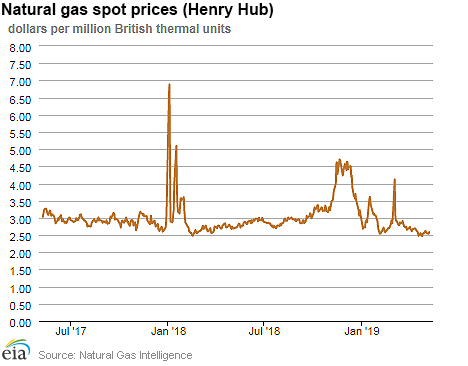
| Spot Prices ($/MMBtu) | Thu, 02-May |
Fri, 03-May |
Mon, 06-May |
Tue, 07-May |
Wed, 08-May |
|---|---|---|---|---|---|
| Henry Hub |
2.60 |
2.57 |
2.54 |
2.54 |
2.59 |
| New York |
2.38 |
2.24 |
2.31 |
2.27 |
2.35 |
| Chicago |
2.41 |
2.33 |
2.37 |
2.34 |
2.37 |
| Cal. Comp. Avg.* |
2.40 |
2.25 |
2.54 |
2.59 |
2.52 |
| Futures ($/MMBtu) | |||||
| June contract | 2.589 |
2.567 |
2.524 |
2.537 |
2.610 |
| July contract |
2.624 |
2.600 |
2.560 |
2.573 |
2.646 |
| *Avg. of NGI's reported prices for: Malin, PG&E Citygate, and Southern California Border Avg. | |||||
| Sources: Natural Gas Intelligence and CME Group as compiled by Bloomberg, L.P. | |||||
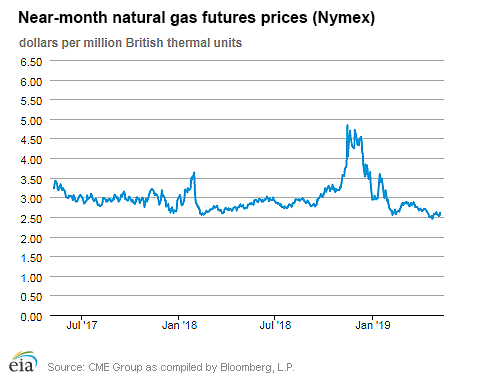
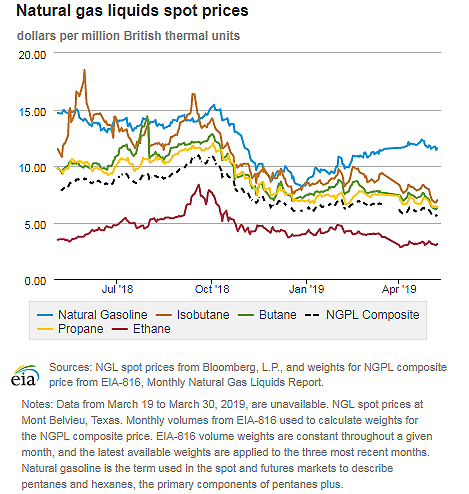
| U.S. natural gas supply - Gas Week: (5/2/19 - 5/8/19) | |||
|---|---|---|---|
Average daily values (Bcf/d): |
|||
this week |
last week |
last year |
|
| Marketed production | 100.2 |
100.5 |
91.2 |
| Dry production | 89.4 |
89.6 |
80.9 |
| Net Canada imports | 5.0 |
4.7 |
5.8 |
| LNG pipeline deliveries | 0.1 |
0.1 |
0.1 |
| Total supply | 94.4 |
94.3 |
86.7 |
|
Source: OPIS PointLogic Energy, an IHS Company | |||
| U.S. natural gas consumption - Gas Week: (5/2/19 - 5/8/19) | |||
|---|---|---|---|
Average daily values (Bcf/d): |
|||
this week |
last week |
last year |
|
| U.S. consumption | 59.9 |
61.6 |
56.3 |
| Power | 24.7 |
23.2 |
25.6 |
| Industrial | 20.2 |
20.6 |
20.1 |
| Residential/commercial | 15.0 |
17.9 |
10.6 |
| Mexico exports | 4.6 |
4.6 |
4.4 |
| Pipeline fuel use/losses | 5.9 |
6.0 |
5.4 |
| LNG pipeline receipts | 5.5 |
5.1 |
3.6 |
| Total demand | 76.0 |
77.4 |
69.7 |
|
Source: OPIS PointLogic Energy, an IHS Company | |||
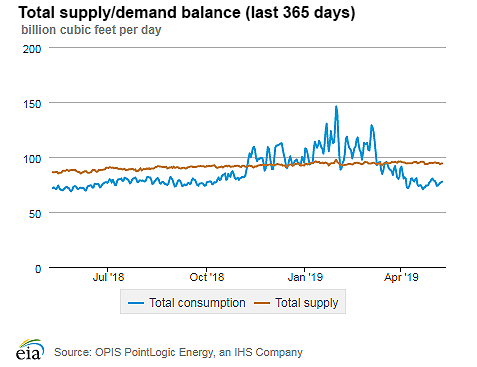
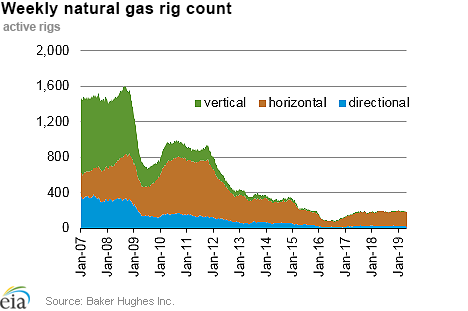
| Rigs | |||
|---|---|---|---|
Tue, April 30, 2019 |
Change from |
||
last week |
last year |
||
| Oil rigs | 807 |
0.2% |
-3.2% |
| Natural gas rigs | 183 |
-1.6% |
-6.6% |
| Note: Excludes any miscellaneous rigs | |||
| Rig numbers by type | |||
|---|---|---|---|
Tue, April 30, 2019 |
Change from |
||
last week |
last year |
||
| Vertical | 46 |
-2.1% |
-16.4% |
| Horizontal | 873 |
0.0% |
-4.4% |
| Directional | 71 |
0.0% |
10.9% |
| Source: Baker Hughes Inc. | |||
| Working gas in underground storage | ||||
|---|---|---|---|---|
Stocks billion cubic feet (Bcf) |
||||
| Region | 2019-05-03 |
2019-04-26 |
change |
|
| East | 299 |
279 |
20 |
|
| Midwest | 309 |
290 |
19 |
|
| Mountain | 78 |
75 |
3 |
|
| Pacific | 162 |
152 |
10 |
|
| South Central | 699 |
666 |
33 |
|
| Total | 1,547 |
1,462 |
85 |
|
|
Source: Form EIA-912, Weekly Underground Natural Gas Storage Report | ||||
| Working gas in underground storage | |||||
|---|---|---|---|---|---|
Historical comparisons |
|||||
Year ago (5/3/18) |
5-year average (2014-2018) |
||||
| Region | Stocks (Bcf) |
% change |
Stocks (Bcf) |
% change |
|
| East | 240 |
24.6 |
317 |
-5.7 |
|
| Midwest | 237 |
30.4 |
367 |
-15.8 |
|
| Mountain | 91 |
-14.3 |
122 |
-36.1 |
|
| Pacific | 194 |
-16.5 |
230 |
-29.6 |
|
| South Central | 657 |
6.4 |
814 |
-14.1 |
|
| Total | 1,419 |
9.0 |
1,850 |
-16.4 |
|
| Source: Form EIA-912, Weekly Underground Natural Gas Storage Report | |||||
| Temperature – heating & cooling degree days (week ending May 02) | ||||||||
|---|---|---|---|---|---|---|---|---|
HDD deviation from: |
CDD deviation from: |
|||||||
| Region | HDD Current |
normal |
last year |
CDD Current |
normal |
last year |
||
| New England | 125 |
26 |
33 |
0 |
0 |
0 |
||
| Middle Atlantic | 90 |
7 |
12 |
0 |
0 |
-2 |
||
| E N Central | 107 |
20 |
19 |
1 |
-1 |
-1 |
||
| W N Central | 109 |
32 |
29 |
0 |
-4 |
-2 |
||
| South Atlantic | 18 |
-18 |
-7 |
37 |
13 |
12 |
||
| E S Central | 18 |
-15 |
-21 |
24 |
13 |
17 |
||
| W S Central | 7 |
-4 |
-20 |
47 |
13 |
28 |
||
| Mountain | 89 |
0 |
13 |
17 |
5 |
7 |
||
| Pacific | 41 |
-11 |
-22 |
1 |
-4 |
1 |
||
| United States | 69 |
5 |
3 |
15 |
3 |
6 |
||
|
Note: HDD = heating degree day; CDD = cooling degree day Source: National Oceanic and Atmospheric Administration | ||||||||
Average temperature (°F)
7-day mean ending May 02, 2019
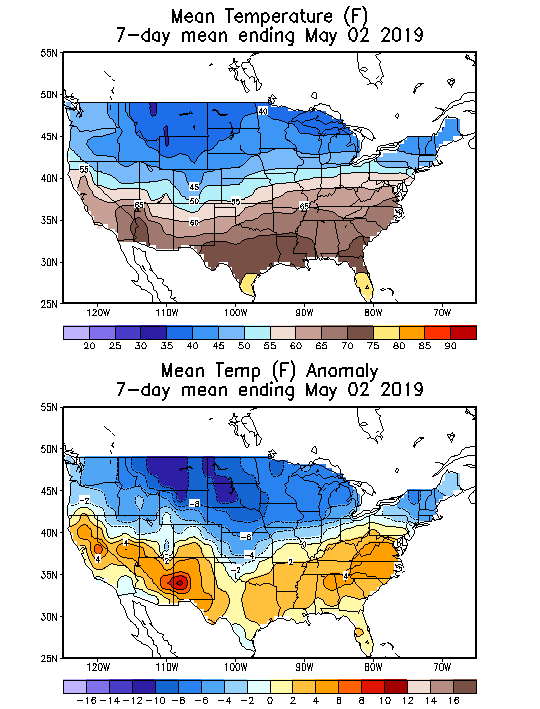
Source: National Oceanic and Atmospheric Administration
Deviation between average and normal (°F)
7-day mean ending May 02, 2019

Source: National Oceanic and Atmospheric Administration

